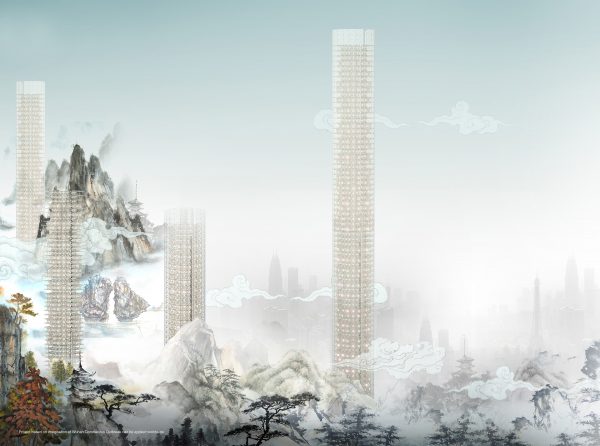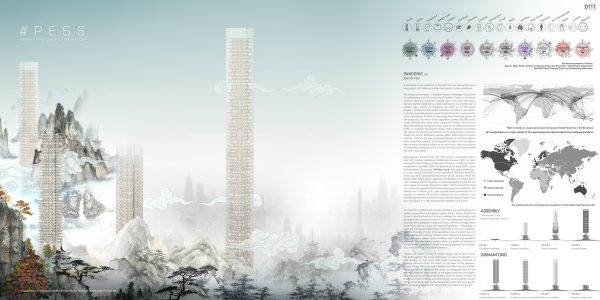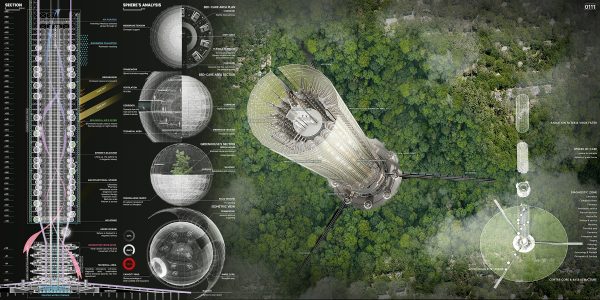Honorable Mention
2020 Skyscraper Competition
Ngo Thanh Ha Tien, Dao Duy Tung
France
According to the report of the Swedish Global Challenges Foundation in collaboration with the University of Oxford’s Future of Humanity Institute, there’s a 5 percent chance that in the next 100 years, humans will be wiped out by a global pandemic or a nuclear war. A century ago, a strain of pandemic flu killed up to 100 million people—5 percent of the world’s population. In 2013, a new mystery illness swept the west coast of North America, causing starfish to disintegrate. In 2015, a big-nosed Asian antelope known as the saiga lost two-thirds of its population—some 200,000 individuals—to what now looks to be a bacterial infection. Faced the risk of Biological warfare (BW)—also known as germ warfare—which is the use of biological toxins or infectious agents such as bacteria, viruses, and fungi with the intent to kill or incapacitate humans, animals or plants as an act of war; and the evolution of unidentified influenza, are we human beings on our way to meet the end of the world?
Every second decade since the 18th century, humankind had to deal with a deadly pandemic. Started with the year 1972, we were having The Great Plague of Marseille in France, in 1820 the Cholera pandemic, and then 1920s the Spanish flu. In early 2020, a virus with the name Corona, the “Wuhan virus” referred to these days, is a new virus of the corona strain (dubbed 2019-nCoV or nCoV), which has never been detected before.
On 31 January 2019, the World Health Organisation declared the outbreak of a novel coronavirus a global health emergency, an acknowledgment of the risk the virus poses to countries beyond its origin in China and of the need for a more coordinated international response to the outbreak. The fatality rate in Wuhan is 4.1 percent and there is currently still no vaccine to prevent 2019-nCoV infection. At this infection rate, the Chinese government ordered to build a 60,000-square-metre structure with space for 1,000 beds and 30 intensive care wards.
On behalf of a global citizen and an architect, we were thinking of a system of pandemic emergency supply station, whose target is to brave a situation like this of a virus’ outbreak. Its main function will be urgent care service in order to fill in the inadequate hospital resources with a program of diagnosis room, intensive therapy, treatment room, bed-care area with medical equipment… Especially, to meet the emergency requirement, the building has to use modularization technology in order to be assembled in a very short time. vertically configured buildings facilitate more efficient infrastructure in case metropole, where occurs primarily the most case of a pandemic outbreak. This emergency supply station is capable of adapting to many terrains, especially in areas with poorly prepared for an epidemic, such as Africa, Asia, South America…
Viruses are a public enemy of human beings, and to take a win in the battle against the novel coronavirus as early as possible is a goal shared by the world. The novel coronavirus outbreak is drawing concerns from the world. In the face of the epidemic, human beings share the same destiny, and only unity and collaboration are able to generate the power to safeguard lives. At this moment, what the world needs is not hypes made by the busybodies, the prejudices and discrimination from the narrow-minded, or the irresponsible labeling and distorting by certain western media. Unity and goodwill shall be the mainstream. And after each pandemic, a lesson is learned: It’s “not yet time to let down our guard”.

















